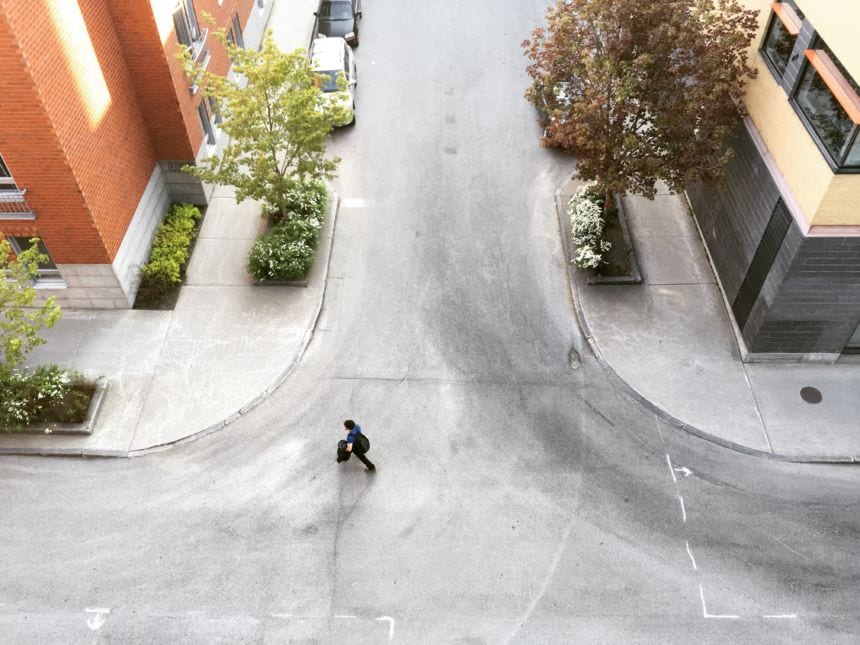The Group That Builds the Future Together
A Conversation with Jonathan F.P. Rose and Prabhjot Singh
By Garrison InstituteDeveloper Jonathan Rose and physician Prabhjot Singh each published books infused with systems thinking in 2016. Rose’s The Well-Tempered City: What Modern Science, Ancient Civilizations, and Human Nature Teach Us About the Future of Urban Life offers a model for how to design our cities in ways that increase the equality, resilience, adaptability, and well-being of its residents. Singh’s Dying and Living in the Neighborhood: A Street-Level View of America’s Healthcare Promise takes a look at the healthcare system by stepping outside the walls of hospitals and clinics and into the neighborhoods where the health of communities is actually determined.
In the following conversation Rose and Singh discuss the relationship between individuals and systems, the need to bring their different fields into meaningful dialogue, and the importance of having an aspirational vision for the future. —Sam Mowe
Prabhjot Singh: In your book, Jonathan, you really bring the psychology of communities to the fore when you write about stress, isolation, connectivity, and meaning as being key concepts for how we make sense of where we are in terms of our collective health. In my own research, I found that sociologist Aaron Antonovsky also speaks about the importance of developing a sense of coherence or meaning before you can even begin to be able to start taking care of your own health.
Economists sometimes reduce this idea in the following way: people with chronic conditions, who are low income and live in a world of scarcity, don’t necessarily think of the future as much as they do the present. This matters because diabetes, depression, anxiety, and obesity are really conditions that necessitate long-term care and are not just about the decisions in front of you. This can make things difficult in my work in the healthcare system because, while a sense of purpose and connection is absolutely essential to all of my patients, it’s a challenge to know how to bring that into my work as a physician.
Jonathan Rose: This reminds me of a study I refer to in my book about the refugee camps in Rwanda after the war. It shows how the people who mentally recovered from the war were those who had a large worldview. It’s almost like the trauma that they experienced broke their mind into shards and the sharp points of the shards cause them enormous pain. Those who had a large worldview could put those pieces back together, like a jigsaw puzzle, into a coherent sense of who they were and their purpose. Those are the people who healed. The people who could not do that did not heal. So having meaning, purpose, and a larger sense of wholeness helps us find our individual wholeness in a very chaotic world.
Both of our books describe how each of us is deeply embedded in systems and no person is alone. You describe how part of the whole healthcare system outreach strategy is to take people who are not connected and to simply connect them. Just re-introducing them into a social community can often be an important step in healing.
Prabhjot Singh: Yes, that’s right. As I was reading your book, I was thinking about how, in many ways, the subject of my book was Ray, a patient of mine who died in the context of a community. The subject of your book is really the living organism of a city or a neighborhood. I’m struck by the idea that we are organisms within organisms, individuals in the context of a community. We’re connected to each other, of course, but we’re also connected to our environment.

Jonathan Rose: Everything is nested. People are nested in families and in social systems. They’re nested in neighborhoods, and the neighborhoods are nested in larger cities. One really interesting thing is that there has been an inaccurate theory that, as the world became more online, we would become less connected to our neighborhoods. That didn’t happen. I think we’ve found that being online can expand our neighborhood, but the physical place itself still deeply matters to who we are and to our health and well-being.
Prabhjot Singh: This reminds me, I recently read that Amazon is starting to open up brick-and-mortar stores. You’ve also got online food delivery companies that are starting to open physical stores again. It’s almost like being embedded in a physical world is, like bellbottoms, back in style. It also makes you think about the last 10 or 20 years as being, in some ways, like an interesting bubble or anomaly where we truly believed that we were going to be untethered from place.
It’s a bit of a rude awakening because, in many ways, this attitude has untethered us from being healthier as a society. Those things seem to be related to each other.
Jonathan Rose: I believe they are. The Trust for Public Land has promoted the idea that access to parks and open space improve our health. We know that when people are in parks their mental health improves, but they also exercise more. They started saying everybody should be within a 10 minute walk of a park and then they created something called “Park Score,” which actually measured that on the map.
What they discovered is that if you live in a neighborhood where there is a gang line between you and the park, you can’t get there. Or if there’s a lot of drug dealing in a certain place or a dangerous corner then, even though it may be 10 minutes by map, it may be 20 or 30 minutes by social reality.
Prabhjot Singh: Yes, what appears to be an objective map of a neighborhood can be so deeply subjective. How you read that environment shapes not only how you see your neighborhood or your city, but it’s actually a great analogy for whether or not there is a health system around you, especially at this moment when we’re increasingly close to claiming we have healthcare access or coverage for every American.
When you actually talk to people in neighborhoods, they see a radically disjointed, disconnected, and very difficult-to-access environment. Even if they’re able to get to a clinic, they don’t necessarily feel access to all the things that they need to feel healthy. It doesn’t have to be a physical cognate of the gang line, but there can be a sense of disjointedness. This kind of the street-level view is imagined so clearly by Jane Jacobs, which, actually is why the title of my book is a riff on the title of her book, The Death and Life of Great American Cities.
Jonathan Rose: Well, I actually think Jane Jacobs only gives us part of the answer. As the patron saint of the neighborhood, Jacobs understood the diversity and complexity of neighborhoods and how they work. That was extremely important. But the adulation of Jane Jacobs is often posited in contrast to Robert Moses, the great master builder who was arrogant and independent and just slammed things through neighborhoods. In many ways, the Jane Jacobs vision won.
The reality is that what our cities and what our health systems need for well-being is a mix between Jane Jacobs and Robert Moses. What we lost on the Robert Moses side was the value of having a big vision. Much of planning post-Jane Jacobs became very small. There’s a lot of friction that comes with an enormous amount of neighborhood process that makes it harder for neighborhoods to change. I believe neighborhood process is very important, by the way, but what we lost with our focus on the neighborhood level, is the focus on having a big visions and high aspirations. I don’t think that should be done in a Moses way, but I do think that kind of thinking needs to be brought back.
One of the things I loved about your book, for example, was this idea of 100 million healthy people. This is what it means to have a larger vision. New York City has proclaimed that it wants to reduce its climate impacts by 80% in 2050, but they have not proclaimed that they want everybody to be healthy by 2050. The Jane Jacobs worldview has not yet included that kind of scaling up to a high level of aspiration.

Prabhjot Singh: That’s so interesting. I wonder if part of the tension that you’ve described is actually a question about the maturity of the respective worlds that we’re coming from. In some ways, the world that I’m speaking about is really a healthcare system that was born in 1965 at the passing of the Medicare, Medicaid, and the Social Security Act. Over the last 50 years, we’ve accreted a lot of grand visions in healthcare. In some sense, it may just be the time in my field for a Jane Jacobs moment to create some balance between big vision and street-level view.
Jonathan Rose: My sense is that an understanding of systems has just started to permeate culture and influence the way that a lot of administrators, planners, and organizers think. We’re starting to realize that solutions are not linear and single point. Solutions are organic and involve whole systems. With the emergence of this new worldview, it is necessary for the birth of integrated health and neighborhood systems. I think we’re just at that cusp now.
Prabhjot Singh: That’s a great question to explore: Where are the points of convergence in these two professionally distinct lines of thought? They’re deeply connected when it comes down to the physical outlay that we’re describing.
Jonathan Rose: I feel like we’re at a moment of change. There’s now a rapid movement in the affordable housing field to integrate health and housing. As you’ve described, the healthcare systems understand their role. Housing understands their role. Just in the last year or two, we’re seeing all these conferences and collaborations and people trying to understand how to integrate and where the cost/benefit savings might be.
There’s also a concept that’s emerging called “communities of opportunity.” These are certain places that are much more supportive of individual opportunity than others. These places have affordable housing, great healthcare systems, great education systems, parks and open space, mass transit, jobs, access to fresh food, and arts and culture. These are communities that also have places of reflection, contemplation, and spiritual resources. The phrase “communities of opportunities” has systems thinking embedded within it. This idea isn’t entirely new, but I think the scaling of the idea has reached a moment of critical mass.
Another thing worth mentioning is the emergence of community health indexes, which have been around for a while. These assess the degree of all kinds of factors that are measurements of community health, such as affordable housing, climate impacts, negative chemicals in the environment, teenage suicide rates, third grade reading performance, asthma, diabetes, and other things. We can now measure hundreds of these kinds of factors and we can begin to see how interdependent they are. With big data and small data, we can track where we are and see the efficacy of our efforts aw we move closer or farther away from the goals that we can set. So we actually have the tools now to visualize systems better and I think that will be helpful for us thinking more systemically.

Prabhjot Singh: Agreed. These kinds of measurements can really help us answer different dimensions of the question: What does it mean to be a healthy place?
I think our ability to actually understand the ebb and flow of these places in ways that are meaningful to people in both your professional space and those in healthcare is part of what actually allow these different fields to start to merge a little bit.
Jonathan Rose: To do that effectively, I think, we need a collective worldview shift. This is very hard, but it’s essential. For example, as a developer of affordable housing, I think of the housing in relationship to health and parks and all of that. But I think of the housing as the center of the system. The healthcare system, of course, because of the way compensation works, thinks of itself as the center of the system. The Trust for Public Land and Nature Conservancy think that the parks are the center of the system. The schools think they’re the center of the system. The police think they’re the center of the system.
The big challenge is: How do you shift your consciousness to both hold, understand, and manage your own territory, while also seeing yourself as part of the whole system and not the center of it?
Prabhjot Singh: It’s a spot-on question. The centrality in healthcare, for example, has traditionally been in hospitals. That whole concept, I think, is starting to really disintegrate. We’re rapidly moving away from that. But to your point, these shifts can just leave us in a starburst shape rather than actually leading us to reimagine the relationships that are involved here.
One thing that I explore in my book is Elinor Ostrom’s work on common-pool resources. How do we govern the commons? How do we interact with the commons? And, one question I’ve struggled with is: What is the commons? What is a common-pool resource that we’re actually managing together? Because it’s not health, per se, because that is self-referential. It could be well-being. It could be happiness. It could be the narrative. It could be a sense of coherence. I’m not sure.
But I wonder if the way that we walk forward to finding a new center is asking ourselves: What is it that we’re managing together and that we each have a role in?
Jonathan Rose: Yes, one of the things I feel that is most damaging about the current political system is it is completely undermining the sense of commons. I think that our sense of commons is essential for society to recognize its responsibility for all its parts, to integrate, and to evolve.
To do that actually requires a different state of mind. Einstein said, “You can’t solve a problem in the state of mind that created it,” and it’s siloized thinking that is creating most of our problems. And it’s integrative systems thinking that is solving these problems. We need to figure out what the mechanisms are that can bring us into an integrative state of mind when we gather together to try and solve systemic problems.
Prabhjot Singh: I often think about a concept I learned about growing up in the Sikh tradition, which is this idea of sangat. Sangat is a word derived from Sanskrit—a compound word of san and gat—that means, essentially, the group that builds the future together. To me, the idea of a community building a future together is a little more meaningful as a concept than just a community. It includes the idea of purpose, directionality, and even a sense of work is implied in the word. For the true community that’s building the future together, an essential pre-requisite of this task is identifying and addressing a vision that we hold dearly and deeply.
And then we must do the work to move towards the vision. Because only when there is a sense of deep connection between the spiritual community’s vision and the sheer work that it takes to change our habits so that we can re-align with the vision is a community real or powerful.
Jonathan Rose: I love it. It’s interesting, as Buddhists we use the word sangha all the time, but we don’t use it in that way. And I think the way you’re using it is an improvement.
Photos courtesy of unsplash.com
